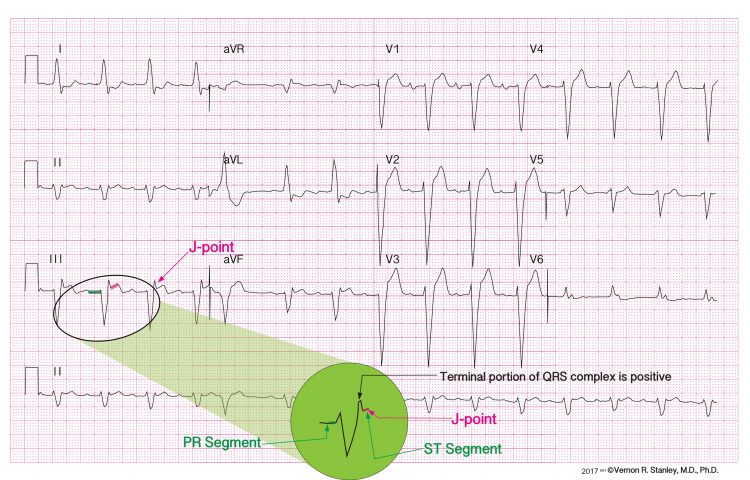Tracing 21
Tracing 21: STEMI?
We observe the following from the above tracing:
- |QRS| > 0.12 sec
- RSR’ Lead V6
- Peaked Ts and ST elevation V1 → V6
- Lead I all upright with notch or slur
Summary: LBBB with Secondary T-wave changes
No. This tracing is not an Acute STEMI.
Tracing 22.a. & 22.b.
22.a. (Hour 0)
22.b. (Hour 1)
Tracings 22a and 22b: STEMI?
From the above tracings we observe:
At time “o hours” the T-waves are noted to be low voltage and asymmetrical as we would expect to see on a “normal” ECG. This tracing does meet the criteria for LVH.
At time “1 hour”, the T-waves have become peaked, symmetrical, broad based.
The patient is presenting with ACS symptoms.
Yes. These tracings represent an evolving STEMI.
Tracing 23
Tracing 23: STEMI?
In the above tracing we observe:
- |QRS| > 0.10 sec
- PR < 0.12 sec
- Presence of Delta waves
- Significant Q-waves V1, III, avF
Summary: The triad criteria for the WPW pattern is present. Distortion by the WPW manifests as seen in V1, III, avF with the presence of significant Q-waves. This is probably a pseudoinfarction pattern.
No. This is not an Acute STEMI.
Tracing 24
Tracing 24: STEMI?
We observe the following from the above tracing:
- ST elevation: I, avL, V1 → V6
- ST depression: III, avF
- Hyperacute T-waves and ST elevation Leads V1→V6, I, avL
- Of note is the absence of LVH and LBBB
Summary: ST-elevation of the Hyperacute T-wave of the AnterolateralHighlateral MI.
Yes. This tracing is an Acute AnterolateralHighlateral STEMI.
Tracing 25
Tracing 25: STEMI
First let us look at all the Leads with a particular focus on Lead III and note the following:
- This tracing meets the criteria for LBBB
- Applying theModified Sgarbossa Criteria:
- The terminal portion of the QRS complex is positive.
- The J-point is elevated > 1mm →→→→This is a Concordant ST elevation→→→
- This is a STEMI
Summary:
Yes. This is an Acute STEMI and an LBBB.






